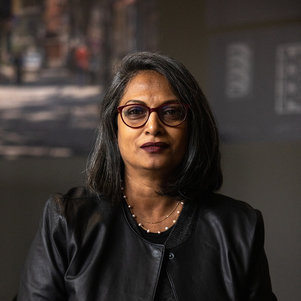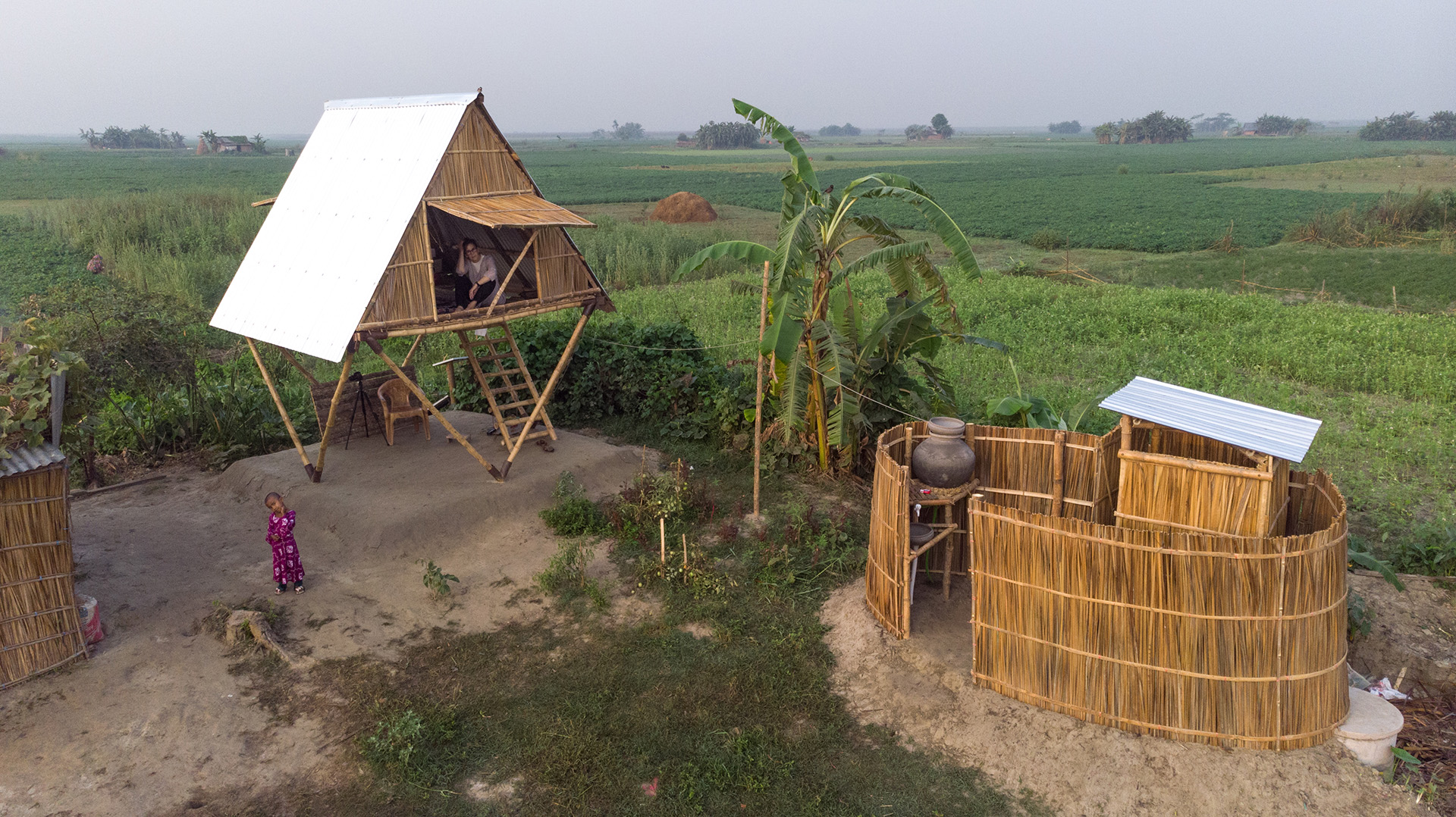Marina Tabassum started as Professor Architectural Design for Climate Adaptation
Living and working in Bangladesh, “Architectural Design for Climate Adaptation” is almost more of a necessity than a choice for Marina Tabassum. She brings her personal style to it, combining knowledge of local climate, materials history, culture and community. Marina Tabassum has started as Professor at our faculty on 15 September 2023.
Marina Tabassum has always been outspoken about the commodification of architecture. “The 1990s were an era when architecture became part of consumerist culture”, she recalls. With real estate developers taking over, building became more about commercial value than architectural and social values. “At the time, many glass buildings were being erected in Dhaka, as a projection of iconic architecture from the West. But in our hot and humid climate, a building that is completely covered with glass cannot be used without installing air-conditioning. It is just wrong.” Studying architecture at the Bangladesh University of Engineering, she had been taught according to a Western curriculum. “It was very much about European history and the modernist legacy. I felt that a local language of architecture was lacking.”

Marina Tabassum
Uniqueness
Tabassum decided to go down another road, never working for developers, but instead first teaming up with fellow-architect Kashef Chowdhury, and in 2005 establishing her own practice Marina Tabassum Architects. Ever since, she has been devoted to developing a language of architecture that reflects the place she is practicing in. “Every place you visit has a uniqueness of architectural character, which is actually a response to the local climate and the availability of materials. I took that as my starting point.” Over the years, this approach has borne fruit in many exceptional residential and public buildings. It has also won her many awards, including the 2016 Aga Khan Award for Architecture and the 2021 Soanes medal.
Every place you visit has a uniqueness of architectural character, which is actually a response to the local climate and the availability of materials.
Marina Tabassum
Much more than with plaudits however, Tabassum is concerned with the relevance of her work. “Apart from being rooted in the place it is practiced, architecture should be relevant to the times we live in. It needs to address the questions of our age, such as the global climate crisis. In response to that we have to reduce our use of fossil fuel”, Tabassum says. That means making more use of natural light and air, for example. “Our homes are an extension of ourselves as it were, so we should try to make them breathe on their own. In the past, when we were less dependent on technical means of climate control, we had ingenious ways of achieving that. We can adapt and use these in contemporary ways.”
Disparity
Economic disparity is another issue Tabassum addresses in her work: “In many ways my practice is informed by the differences between the privileged and under-privileged. Coming from a privileged background, I’ve always wanted to make a difference. Indeed, I believe that all of us, whatever our knowledge or profession, should strive to be agents of change.” To reinforce this aspect of her work, she set up the Foundation for Architecture and Community Equity (FACE) in 2020: “We have a team of great young architects that also believe in this; together we are building houses for people affected by climate crisis.”
Bangladesh is greatly affected by climate change. “We have sea level rise, and changes in biodiversity because of salt water increasingly entering the sweet water system. The rainy seasons have become more unpredictable, and there is increased flooding. Then there is the issue of land erosion, caused by melting of the melting of Himalayan glaciers”, Tabassum sums up.
Through her foundation, she is trying to help climate refugees. “Many displaced people, who no longer own land, are reduced to staying on shifting sandbanks in the middle of rivers.” These riverine islands, or chars, are extremely vulnerable to climate change, and their dwellers have to move constantly. “We have developed a housing system of mobile modular structures made from bamboo. The idea is that people can then at least take their home with them, moving from location to location”, she explains “It still needs some engineered joinery which we are supplying. Hopefully, if it catches on as a vernacular idea, people can also make this themselves.”
A housing system of mobile modular structures made from bamboo; Khudi Bari by photographer Asif Salman
Houses alone are not enough, though. “You have to have earning power. If you don’t have a proper income, a house doesn’t make a difference. That is why we are running livelihood programmes for refugees, as well as for local people living near refugee sites, as their livelihood is also being affected”, she explains. “We are designing products with recycled materials, for example, and show people plastic can be a way to start earning money, instead of just waste material. It’s interesting how you can turn something negative into something positive.”
New roles for architects
It is also indicative of how complex architecture as discipline has become. “Nowadays, we need to address so much more than just the aesthetics of buildings. To be able to make your architecture sustainable is not just about whether you build with bricks, or mud or bamboo. You have to take the whole process into account, and become an anthropologist, a sociologist and much more besides a designer”, Tabassum says. “Architecture has to be a be process-driven, collaborative, research-oriented business. There is so much to do, learn and investigate, and I’ll be looking into all of those aspects at TU Delft.”
Nowadays, we need to address so much more than just the aesthetics of buildings.
It will be an extension of the work she has done as visiting professor for the last three years. “Students have been coming to Bangladesh and together we’ve been mostly working on housing for marginalised people. We have a unique landscape here, the largest delta in the world, but also a much denser population than the Netherlands. So how do you keep room for water and provide for human habitation at the same time”, she says. “Materiality is another issue we work on. In this day and age, how do you make buildings natural and source them locally?”
This year, students will be visiting Sylhet. “We’ll be working in this town that has large retention areas for water coming down from Indian mountain ranges. The area is very prone to flooding and we will be figuring out different ways of dealing with that, like floating or mound housing. It is a beautiful landscape, but also very challenging for the people living there.” Tabassum finds a ready audience in her students. “We had more applicants than places for the ing. Most students are interested in this shift in architecture; they are also very much concerned about climate change and adaptation. It is their future, after all.”
Limiting ourselves
Ultimately, the solution lies in limiting ourselves, Tabassum believes. “In our consumer culture, we have been conditioned to believe we need more, we should now reprogramme ourselves and focus on just the necessities. It may not be the ultimate answer, but if we consume less, if only for a few decades, we can affect a lot of change”, she says. “That is also the relevant way of practicing architecture for our times. A lot of people do not have a roof over their head, but we should not build what we do not need, so the best way is to repurpose empty buildings. We already have too many buildings. Even I as an architect can see that.”
More information
- Marina Tabassum is Professor Architectural Design for Climate Adaptation in the Architecture department of the Faculty of Architecture and the Built Environment at the TU Delft. She has her own practice Marina Tabassum Architects in Bangladesh.
- See her professor page here.

